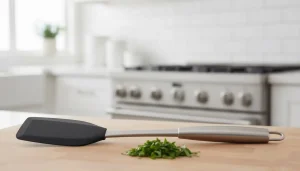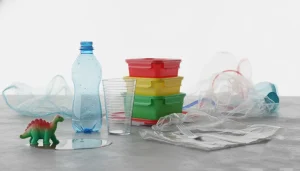If you’re anything like me, you know the frustration of a spatula bending mid-flip or a ladle that stains after one curry night. That’s why I swear by stainless steel cooking tools—Essential kitchen gadgets they’re sturdy, sleek, and dependable. Over the years, I’ve learned that a good set of reliable utensils isn’t just about convenience; it’s about making cooking less stressful and more enjoyable.
This guide is my way of sharing what I’ve discovered. I’ll walk you through why I prefer stainless steel, the essential kitchen gadgets pieces worth investing in, how to pick the right ones, and how to keep them looking brand new. I’ll even compare them to other materials, suggest some trusted brands, and answer common questions people often ask.
So grab your tea (or coffee—no judgment), and let’s dig in.
Why I Prefer Stainless Steel in My Kitchen

Whenever I step into my kitchen, I want tools that make my life easier—not ones that give me more things to worry about. Essential kitchen gadgets that’s where stainless steel shines (literally). Let’s break down why it works so well.
-
Essential kitchen gadgets with long-lasting durability
Plastic can melt, wood can crack, silicone can lose shape. But stainless steel? It’s tough. I’ve used the same spatula for nearly five years, and it looks like it could keep going another five. That kind of reliability means I’m not constantly replacing things.
-
Essential kitchen gadgets with
easy to Clean
I’ll be honest—I don’t have time for complicated cleaning rituals. With stainless steel, most of the time a quick rinse or a spin in the dishwasher does the job. No lingering smells, no stubborn stains.
-
Essential kitchen gadgets with
Safe and Reliable
Unlike some materials, stainless steel doesn’t leach chemicals when exposed to high heat. That peace of mind matters, especially when I’m cooking for my family.
-
Essential kitchen gadgets with
Stylish and Professional
There’s something satisfying about seeing a set of gleaming silver utensils hanging in the kitchen. They give off a professional vibe, even if I’m just flipping pancakes on a lazy Sunday morning.
The Must-Have Stainless Steel Tools in My Kitchen
Let’s talk about the essential kitchen gadgets . Over time, I’ve built a small collection of stainless steel cooking tools that I can’t live without. Here are the ones that earn their keep daily.
Essential kitchen gadgets with
Spatula

Perfect for flipping fish fillets, sautéing vegetables, or scraping the bottom of a pan (especially when curry decides to stick). A solid spatula makes cooking easier—and less messy.
Essential kitchen gadgets with
Tongs
I like to call these my “extra hands.” From grilling chicken to serving pasta, tongs are versatile and dependable. The grip on a good stainless pair is unmatched.
Essential kitchen gadgets with
Ladle
Soup, stew, dal, curry—you name it. My ladle helps me serve without spills and keeps portions consistent.
Essential kitchen gadgets with
Whisk
Whether I’m making pancake batter or whipping up a sauce, my whisk ensures smooth consistency. And yes .Essential kitchen gadgets also good for an arm workout.
Essential kitchen gadgets with
Measuring Cups and Spoons
Baking is science, and accuracy matters. A stainless set doesn’t warp, so measurements stay true.
Essential kitchen gadgets with
Knife Set
A sharp, stainless steel knife set is one of the best investments I’ve ever made. From slicing vegetables to carving meat, it saves time and effort.
Essential kitchen gadgets with
Skimmer
If you fry food often, a skimmer is a game changer. It lets me scoop out crispy pakoras or fries without carrying all the oil with them.
💡 Pro Tip: If you’re into outdoor cooking, these tools perform beautifully on camping trips as well. I’ve shared more about that in my guide to camping cooking tools (worth checking out if you love cooking under the sky).
How I Choose the Right Stainless Steel Cooking Tools
Choosing the right stainless steel tools isn’t just about picking the shiniest set on the shelf. Over the years, I’ve learned that the right tools can make cooking smoother, safer, and even more enjoyable. Here’s my step-by-step approach for selecting the perfect stainless steel kitchen utensils.
-
Look for High-Quality Stainless Steel
Not all stainless steel is created equal. I always check the type of stainless steel used in a tool:
- 18/8 or 18/10 Stainless Steel – Contains 18% chromium and 8–10% nickel. This combination ensures corrosion resistance, durability, and a polished, professional look.
- Avoid Low-Grade Steel – Tools made with lower-quality steel may rust, bend, or stain over time.
💡 Tip: If the manufacturer doesn’t specify the steel grade, it’s a red flag. I like to buy from brands I trust.
-
Assess the Weight and Balance
A tool that feels awkward in your hand will make cooking tedious. I test for:
- Comfortable Weight – Too light and it feels flimsy; too heavy and it tires your wrist.
- Proper Balance – The handle should complement the head of the tool. I often hold the spatula or ladle as if I’m cooking—if it feels right, it passes the test.
For example, a ladle or slotted spoon should feel sturdy without requiring extra effort to scoop liquid.
-
Consider Handle Design
The handle is more than a grip—it affects comfort, safety, and performance. I look for:
- Long Handles: Protect hands from steam and hot surfaces.
- Ergonomic Grip: Non-slip, soft-touch handles are a plus.
- Heat Resistance: Stainless steel can get hot, so handles that stay cool or are coated with silicone are ideal.
- Hanging Hole: Useful for storage and quick access.
Personally, I love handles that combine stainless steel strength with a silicone grip for comfort.
-
Check for Construction and Durability
Durability is key for stainless steel tools. I examine:
- Seamless Construction: Tools with welded or molded handles are stronger and easier to clean.
- Thick Material: The utensil head should be rigid enough to handle dense foods without bending.
- Rust and Corrosion Resistance: Even high-quality stainless steel can corrode if poorly maintained. Look for tools labeled “rust-resistant” or “dishwasher safe.”
💡 Tip: I test tools by lightly bending or twisting the head (without damaging it) to ensure it feels solid.
-
Match Tools to Your Cooking Style
Different kitchens require different tools. I ask myself:
- Do I cook mostly soups and sauces? → Ladles and spoons are essential.
- Do I bake or grill frequently? → Spatulas, tongs, and whisks are must-haves.
- Do I often use non-stick cookware? → Choose stainless steel with silicone or silicone-tipped heads to avoid scratching.
Your cooking habits dictate the tools that will see the most use.
-
Consider the Tool’s Size and Functionality
Size matters, and not all utensils fit every task:
- Ladles: Small for sauces, large for soups or punch.
- Spatulas: Thin and flexible for flipping, thick and sturdy for heavy foods.
- Tongs: Long enough to reach into deep pans, but not so heavy that you lose control.
I always pick tools that can multitask without compromising their primary function.
-
Ease of Cleaning and Maintenance
Even the best tool is useless if it’s difficult to clean:
- Dishwasher Safe: Most stainless steel tools are, but handwashing prolongs life.
- Smooth Finish: Avoid tools with crevices where food can get trapped.
- Corrosion Resistance: Polished stainless steel resists stains and rust.
💡 Pro Tip: I keep a separate set of silicone or wood tools for delicate non-stick surfaces.
-
Brand Reputation and Warranty
I usually stick with brands known for quality:
- All-Clad, Calphalon, OXO, Home Hero – Trusted brands with consistent durability.
- Lifetime Warranty or Guarantee: A sign of confidence from the manufacturer.
Investing in high-quality tools pays off in the long run. Cheap, low-grade utensils often warp, rust, or break quickly.
Taking Care of Stainless Steel Cooking Tools
If you want your tools to last years (or even decades), a little care goes a long way.
Clean Quickly:
-
Don’t leave them soaking in water for days. Wash and dry soon after use.
-
Avoid Harsh Scrubbers:
Steel wool can scratch. I use softer sponges.
-
Polish Occasionally:
A gentle polish keeps the shine intact.
-
Store Properly:
Hanging racks or drawer organizers keep utensils from banging into each other and scratching.
Comparing Stainless Steel With Other Materials
Before I switched almost completely to stainless steel, I experimented with other materials. Each has its perks, but here’s how they compare.
Plastic

When you hear “plastic cooking tools,” you might think of cheap, bendy spatulas or spoons that melt the second they touch a hot pan. I’ve been there. I once tried flipping an omelet with a flimsy plastic spatula, and let’s just say—it ended up looking more like scrambled eggs.
But here’s the truth: plastic utensils have evolved. Modern versions are safer, sturdier, and surprisingly practical. While they don’t replace everything in my kitchen, they do serve specific purposes really well. And for anyone who wants affordable, lightweight, and colorful tools, plastic deserves a spot in the drawer.
This guide dives deep into why plastic cooking tools are still around, the best ones to keep on hand, their pros and cons, maintenance tips, how they compare with other materials, and whether they’re really worth buying.
So, let’s talk plastic—without the guilt
Pros: Lightweight, cheap, often colorful.
Cons: Can melt, warp, or leach chemicals at high heat.
Wood
If you’ve ever cooked with wooden utensils, you know there’s something special about them. They have a natural feel, a warm touch, and a certain charm that plastic or stainless steel just can’t match. Over the years, I’ve found that wooden cooking tools are more than just aesthetic—they’re functional, durable, and surprisingly versatile.
In this guide, I’ll share why I love wooden cooking tools, the essential pieces to keep on hand, tips for selecting the best ones, how to maintain them, and how they compare with plastic and metal alternatives. We’ll also look at safety concerns, brands I trust, and answer the most common questions I get from readers.
So grab a cup of tea, and let’s talk about wood in the kitchen.
- Pros: Natural, rustic look, gentle on cookware.
- Cons: Absorbs odors, stains easily, can crack.
Silicone
If you’ve ever struggled with a spatula that bends too much, scratches your pan, or melts halfway through cooking, silicone cooking tools might just be your best friend. I remember my first silicone spatula—it felt so flexible yet sturdy, and I couldn’t believe how it made even the trickiest tasks easier.
Silicone tools have become a kitchen staple because they combine durability, safety, and versatility. In this guide, I’ll walk you through why I rely on silicone, the essential tools to have, tips for choosing the right ones, maintenance advice, how they compare to other materials, and everything else you need to know to cook like a pro—without scratching or burning anything.
-
Pros: Flexible, heat-resistant, doesn’t scratch non-stick pans.
-
Cons:
Can lose firmness over time, sometimes retains stains.
Stainless Steel
If you’ve ever wondered why professional chefs prefer stainless steel utensils, you’re not alone. I’ve spent years experimenting with different materials in my kitchen, and I can confidently say stainless steel tools are among the most reliable. They combine strength, heat resistance, and elegance—making them ideal for both daily cooking and special occasions.
In this guide, I’ll share why I prefer stainless steel, essential tools I recommend, tips for choosing the best sets, maintenance advice, comparisons with other materials, and answers to frequently asked questions. By the end, you’ll know exactly what to look for to build a professional-quality kitchen arsenal.
-
Pros:
Durable, sleek, safe, easy to clean.
-
Cons: Heavier, can scratch delicate non-stick coatings if not used carefully.
For me, stainless steel balances everything—style, safety, and strength.
Best Brands for Stainless Steel Cooking Tools
After years of experimenting, these are the names I trust:
-
All-Clad:
Premium quality, built to last decades.
-
Cuisinart:
Great balance of price and performance.
-
OXO:
Ergonomic designs, perfect for daily cooking.
-
KitchenAid:
Stylish sets that work as well as they look.
-
Farberware:
Budget-friendly without feeling cheap.
If you’re serious about building a reliable kitchen collection, investing in at least one premium set is worth it.
The Psychology of Good Cooking Tools
Here’s something I’ve noticed: when I use high-quality tools, I cook with more confidence. It’s almost like having the right gear motivates me to try new recipes.
Think about it. Would you feel excited to cook if your knife is dull and your spatula bends every time? Probably not. Reliable tools remove frustration and bring back the joy of cooking.
Common Questions About Stainless Steel Kitchen Tools
- Can stainless steel utensils scratch pans?
Yes, they can scratch non-stick surfaces if used carelessly. I keep separate silicone tools for those pans. - Are they dishwasher safe?
Most are, but I recommend checking manufacturer instructions. Personally, I still hand-wash my knives. - Do they rust?
High-quality stainless steel shouldn’t rust, but cheaper versions might if left wet. - Are they worth the investment?
Absolutely. Considering they last years (if not decades), the upfront cost pays off quickly.
My Final Thoughts
If I had to sum it up, stainless steel cooking tools are the unsung heroes of my kitchen. They’re tough enough for everyday use, stylish enough to show off, and versatile enough to handle anything I cook. Whether you’re a casual home cook or someone who loves experimenting, investing in a solid set can make your kitchen life smoother.
Cooking should be enjoyable, not frustrating. And trust me, when your tools are reliable, you’ll find yourself smiling more at the stove and stressing less about what might break or bend.
So if you’ve been on the fence, consider this your sign—it’s time to upgrade.